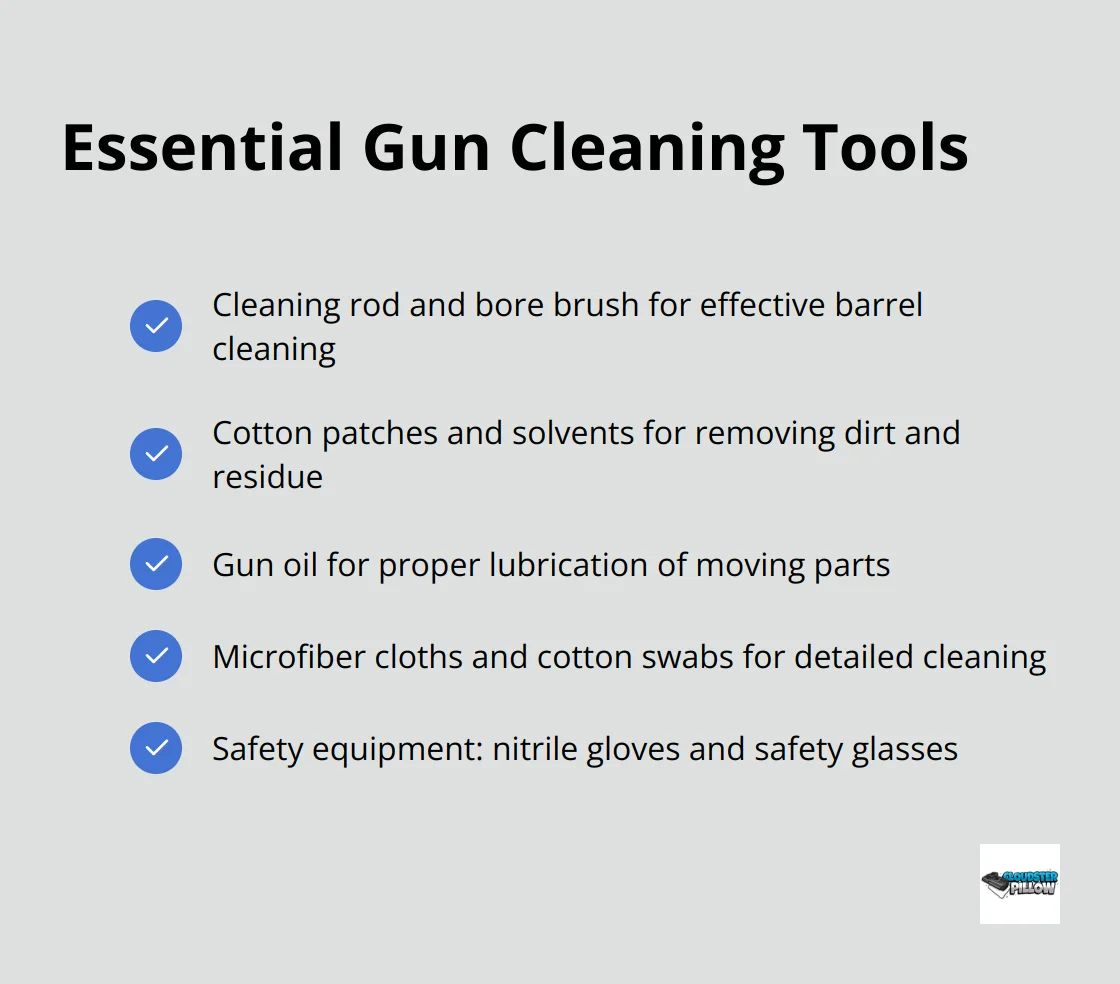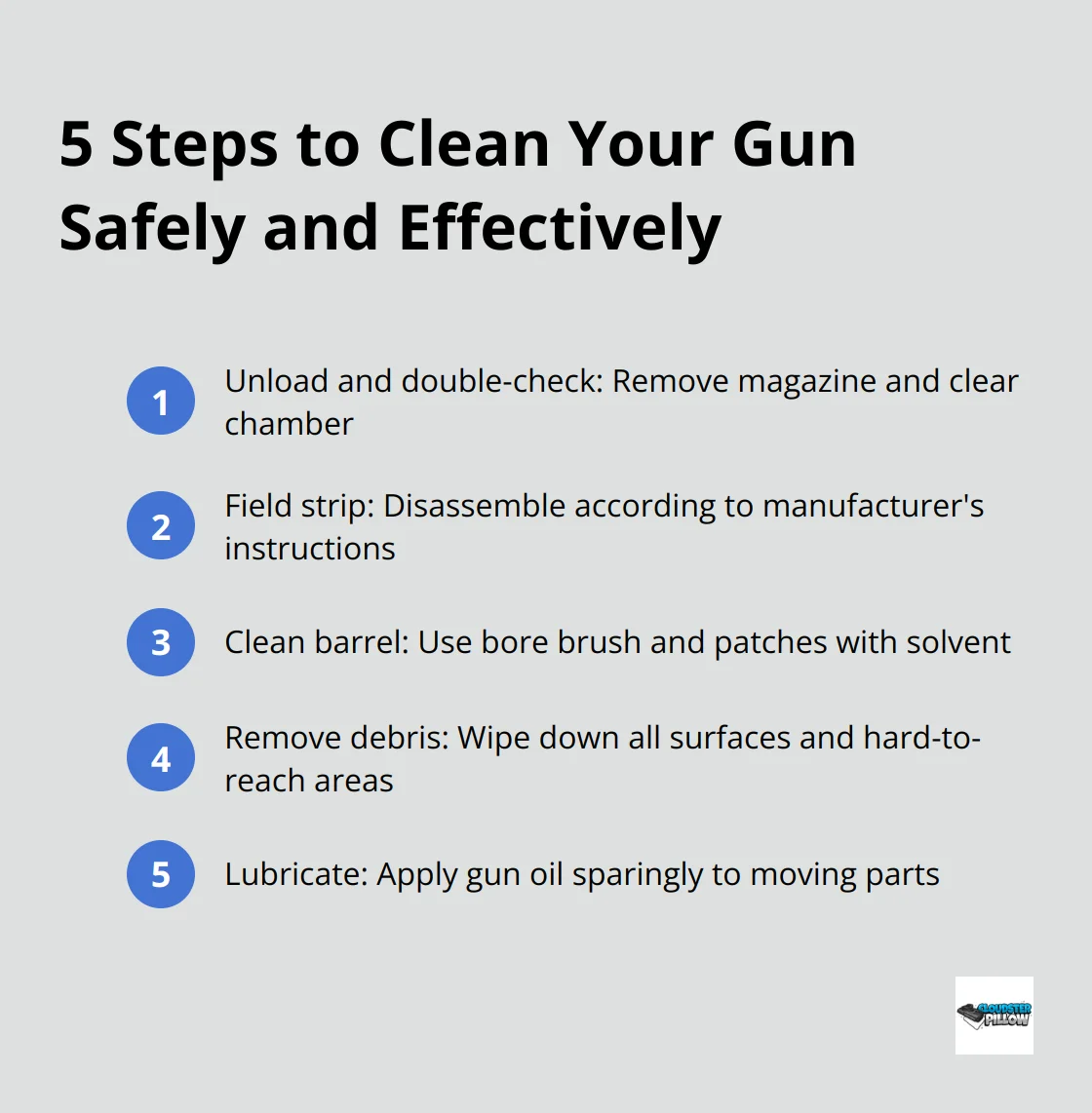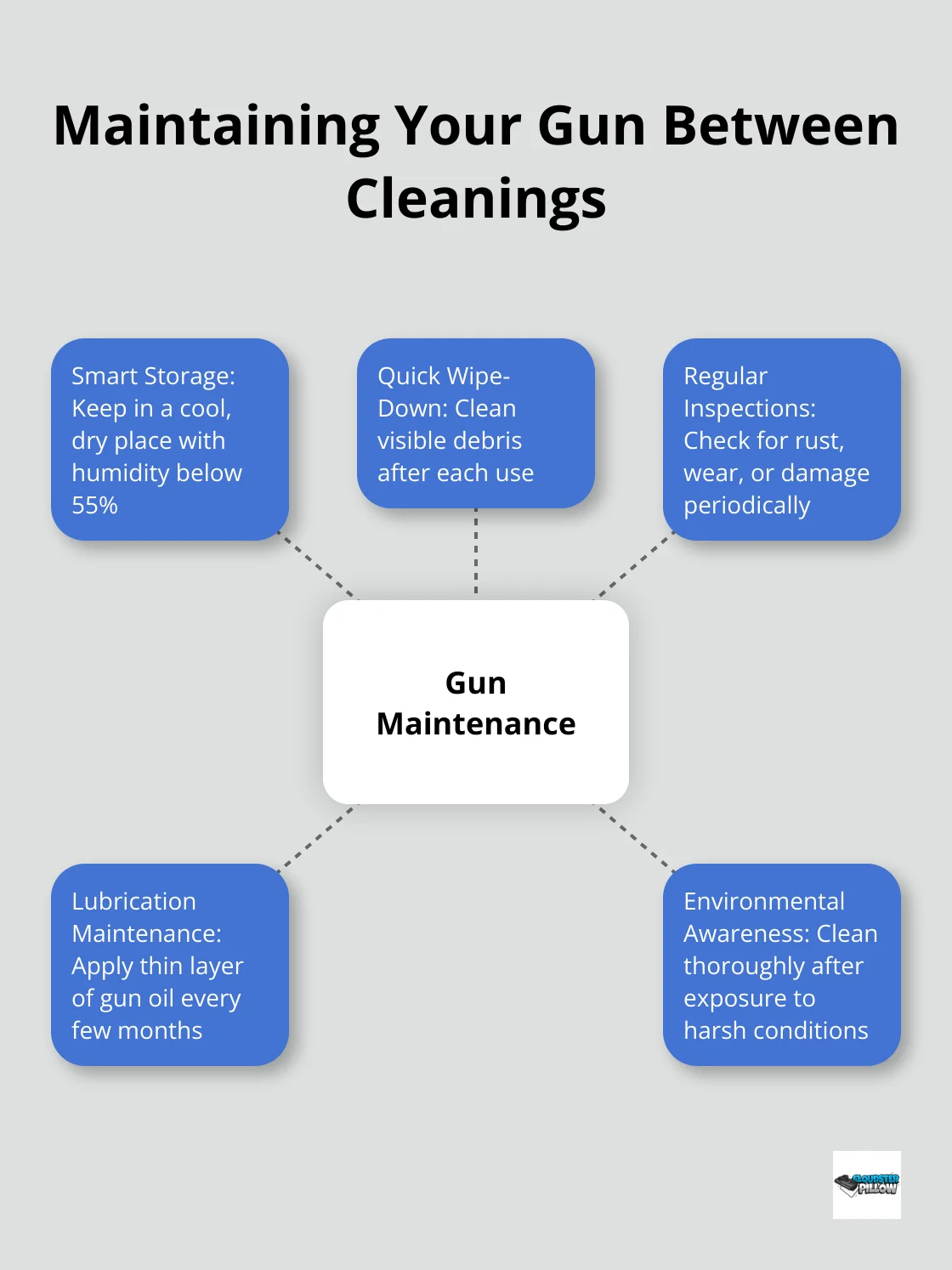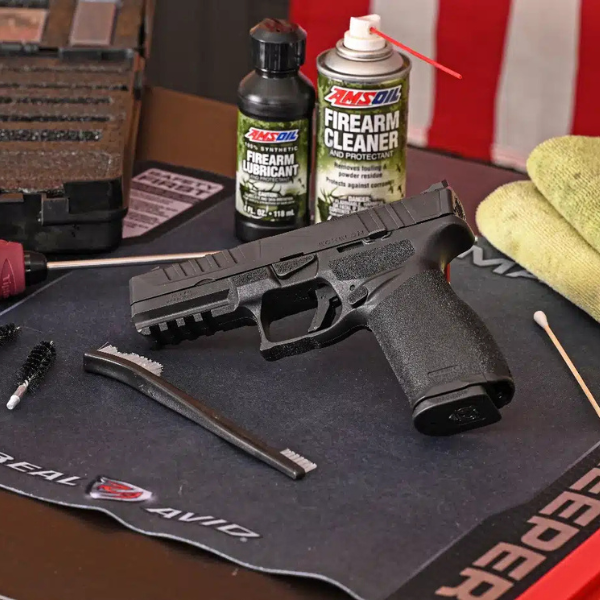Firearm Tips and Tricks
A Step-by-Step Guide to Gun Cleaning
At Cloudster Pillow, we understand the importance of proper firearm maintenance for safety and performance.
Regular gun cleaning is a crucial skill for every responsible gun owner. This step-by-step guide will walk you through the process, from gathering essential tools to developing a consistent cleaning routine.
Let’s dive into the world of gun cleaning and ensure your firearms stay in top condition.
What Tools Do You Need for Gun Cleaning?
Gun cleaning is a vital part of firearm maintenance. The right tools make all the difference. Let’s break down the essential items you’ll need in your gun cleaning kit.

The Cleaning Rod and Bore Brush Duo
Your cleaning rod and bore brush are the workhorses of gun maintenance. Select a one-piece cleaning rod to avoid scratching your barrel. For bore brushes, choose bronze or nylon – they remove grime effectively but don’t damage your firearm. Match the brush size to your gun’s caliber for optimal results.
Patches and Solvents: The Dirt Busters
Quality cleaning patches are essential. We recommend 100% cotton patches for their absorbency and lint-free properties. For solvents, try a reputable brand like Hoppe’s No. 9, the most popular gun cleaning solution in the U.S. Apply it to your patches to dissolve powder residue and lead fouling effectively.
Lubrication: Keep It Moving Smoothly
After cleaning, proper lubrication is key. A high-quality gun oil (like Break-Free CLP) cleans, lubricates, and protects. Apply it sparingly to moving parts and metal surfaces prone to rust. Too much lubrication can attract dirt and grime, so use it judiciously.
Microfiber Cloths and Cotton Swabs
Don’t overlook these simple yet effective tools. Microfiber cloths are perfect for wiping down surfaces without leaving lint behind. Cotton swabs (Q-tips) help you reach tight spaces and corners that larger tools can’t access.
Safety Equipment
Always prioritize safety. Wear nitrile gloves to protect your skin from harsh chemicals and lead residue. Consider using safety glasses to shield your eyes from potential splashes or debris. For those who carry concealed, remember to clean your holster regularly as well.
Now that you’ve assembled your cleaning arsenal, let’s move on to the step-by-step process of cleaning your gun effectively and safely.
How to Clean Your Gun Safely and Effectively

Safety First: Unload and Double-Check
Always treat your firearm as if it’s loaded. Remove the magazine and clear the chamber. Inspect the chamber visually and physically to confirm it’s empty. This step is non-negotiable and should become second nature.
Field Stripping: Know Your Firearm
Consult your gun’s manual for specific disassembly instructions. Each firearm model has unique steps for field stripping. For instance, a Glock 19 requires you to remove the magazine, rack the slide and engage the slide lock to hold the slide back, and visually inspect the chamber to ensure it’s empty. Familiarize yourself with your specific model to avoid component damage.
Barrel Cleaning: The Heart of Your Gun
Start with the barrel, often the dirtiest part. Attach a bore brush to your cleaning rod and dip it in solvent. Push the brush through the barrel from the chamber end to the muzzle. Repeat this process 10-15 times. Next, use a patch holder with a clean, solvent-soaked patch. Run it through the barrel in the same direction. Continue with clean patches until they come out clean.
Debris Removal: Detail is Key
Use your microfiber cloth to wipe down all metal surfaces, removing any visible debris. Cotton swabs prove invaluable for hard-to-reach areas. Pay special attention to the feed ramp, extractor, and ejector – these areas often accumulate residue that can affect reliability.
Lubrication: Less is More
Apply a small amount of gun oil to all moving parts. Focus on areas of metal-to-metal contact, such as slide rails and the barrel hood. Over-lubrication can attract dirt and cause malfunctions, so use just enough oil to create a light sheen on metal surfaces. The U.S. Army has been exploring new lubricants to make weapon maintenance easier for warfighters.
After cleaning and lubricating, reassemble your firearm following the manufacturer’s instructions. Perform a function check to ensure all parts are correctly installed and working properly.
Now that you’ve mastered the cleaning process, let’s explore how to maintain your firearm between cleanings to ensure optimal performance and longevity.
How to Keep Your Gun in Top Shape Between Cleanings

Smart Storage Solutions
Store your firearm in a cool, dry place to prevent rust and corrosion. The ideal relative humidity for gun storage should be no more than 50 to 55 percent. If you live in a humid area, use a dehumidifier in your gun safe. For a budget-friendly option, silica gel packets work well. Replace them every few months to maintain their effectiveness.
Quick Maintenance After Use
Perform a quick wipe-down of your firearm after each shooting session. Use a microfiber cloth to remove visible debris or moisture. Focus on the barrel and action, as these areas are most susceptible to corrosion. This simple step prevents long-term damage and simplifies your next deep cleaning session.
Regular Inspections
Set a schedule to inspect your firearm regularly, even if you haven’t used it. Look for signs of rust, unusual wear, or damage. Check the sights for alignment and the magazine for any deformation. If you carry concealed, inspect your holster for wear that could affect retention.
Lubrication Maintenance
Apply a thin layer of gun oil to metal surfaces every few months, even if the firearm hasn’t been used. This practice prevents rust and keeps moving parts functioning smoothly. Try to use high-quality lubricants for optimal results.
Environmental Considerations
Be aware of your firearm’s exposure to different environments. If you’ve used your gun in dusty, wet, or salty conditions, clean it thoroughly as soon as possible. These environments can accelerate corrosion and affect your firearm’s reliability. For those who carry daily, consider how body heat and sweat might impact your firearm and adjust your maintenance routine accordingly.
Final Thoughts
Regular gun cleaning ensures your firearm remains in top condition, ready for use when needed most. A clean gun is a safe gun, and safety should always be your top priority. Following manufacturer guidelines for your specific model will help you avoid potential damage and maintain optimal performance.
A consistent gun cleaning routine is essential for long-term firearm health. Set a regular schedule based on your usage frequency and adhere to it. Even if you haven’t fired your weapon, periodic cleaning and inspection can prevent issues caused by environmental factors.
For those who carry concealed, comfort is as important as cleanliness. We at Cloudster Pillow offer our adjustable concealed carry pillow to enhance comfort and concealment for inside-the-waistband and appendix carry (making your daily carry experience more secure). Gun cleaning fosters a culture of safety and responsibility, extending your firearm’s life and ensuring reliable function when it matters most.


Pingback: How to Clean a Handgun A Step-by-Step Guide for Beginners - Cloudster Pillow